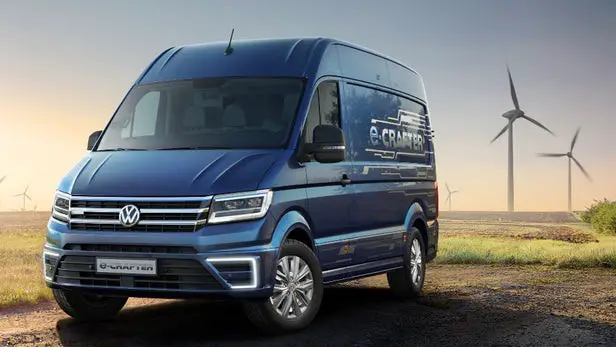
The e-Crafter uses the same 35.8 kWh battery found in the VW e-Golf. Drive is supplied by a 134 bhp electric motor that also has 290 Nm of instant torque, while a single-speed gearbox drives the front wheels. The electric system is packed into the existing Crafter chassis, so that means there’s no compromise in terms of load volume, at 10.7 cubic metres, and the e-Crafter can carry four Euro pallets, just like the standard Crafter panel van with the same body size.
The 3.5 ton cargo van has 107 miles of range and uses a 35 kWh lithium-ion battery, which can be charged to 80% in 45 minutes or so. The e-Crafter was made for craftspeople (men and women), couriers, and for last-mile applications. Its top speed has been limited to 55 mph, and that typically in urban settings such cargo vans may be driven 40–60 miles a day with many stops. Replacing older diesel vans with all-electric ZEV versions would obviously be very helpful in reducing unhealthy air pollution in cities.
The Volkswagen e-Crafter is something of a strange beast. With a body borrowed from a vehicle powered by an internal combustion engine and a soul (electric drivetrain) borrowed from the VW e-Golf, this work-a-day Frankenstein is able to conduct its business about the city without attracting much attention. It blends in like a regular VW Crafter, but without the clatter of a diesel engine.
Range is decent for in town running around, at 107 miles, but with only a 56 mile per hour computer-limited top speed, it’s not cut out for highway usage. It can DC fast charge to 80 percent in 45 minutes given a 40 kW charging station.
The good news is its 100 kW (134 horsepower) motor with 214 pound-feet of torque has plenty of grunt and can get the boxy beast up to speed quite briskly. Its 35-kWh battery is hidden beneath the floor and so doesn’t impinge on its 10.7 cubic meters of carrying capacity.
The dash and controls are pretty much the same except the fuel gauge now indicates remaining energy in the battery and it also lets you know how much energy is being recouped upon braking. The driving experience is improved. Besides the added pep and lack of gear shifting, the regenerative braking is strong enough for a mostly one pedal experience.




